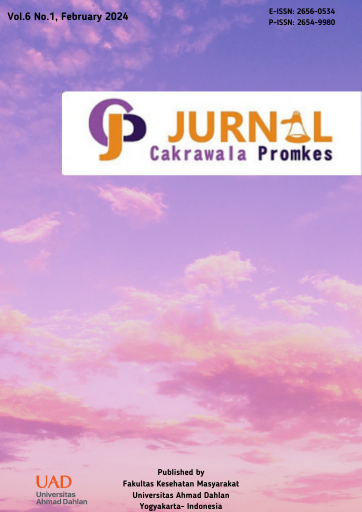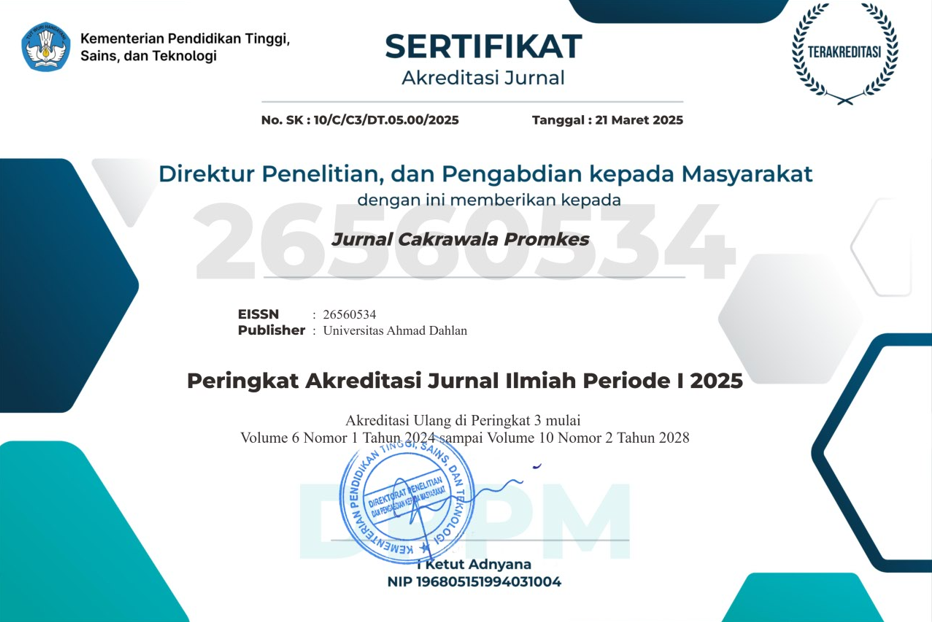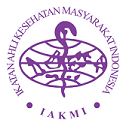Food consumption pattern for hypertension patient in Klaten Regency, Central Java Province, Indonesia
DOI:
https://doi.org/10.12928/jcp.v6i1.8461Keywords:
Food consumption, Hypertension, Patient, Public health centerAbstract
Hypertension, commonly known as high blood pressure, is a grave medical condition that serves as a catalyst for the onset of various other ailments, each bearing significant consequences that may ultimately lead to fatality. Unhealthy eating habits, such as consuming foods heavy in sugar, sodium, or saturated fat, are the primary cause of elevated incidences of hypertension. This research aimed to determine the relationship between food consumption patterns in hypertensive patients. This study used a cross-sectional study design conducted on outpatients at the Prambanan Health Center, Prambanan District, Klaten Regency, from December 2022 to February 2023. The population used in this study were all patients with hypertension in Klaten Regency, which amounted to 2,884 people from January until December 2021. The research sample was taken randomly with a value a of 5%. Based on the sample calculation, the sample size was 339 hypertension sufferers. Data analysis used in this study was univariate and bivariate analysis using the chi-square test with a degree of confidence of 95%. The results of this study indicate that the level of salt, fiber, and fat consumption is not related to sufferer hypertension. Maintaining a nutritious diet and engaging in physical activity as part of a healthy lifestyle may also help lower blood pressure. This study supports the hypothesis that dietary variety might be important for the future. Future research endeavors ought to delve into the intricate relationship between dietary practices and blood pressure across diverse cultural contexts, elucidating how variations in dietary habits influence blood pressure levels. Furthermore, it is imperative to investigate the potential repercussions of elevated blood pressure on various cultural groups, shedding light on tits unique impacts ondifferent societal frameworks.
References
Forouzanfar MH, Liu P, Roth GA, Ng M, Biryukov S, Marczak L, et al. Global burden of hypertension and systolic blood pressure of at least 110 to 115 mmHg, 1990-2015. JAMA. 2017;317:165–82.
Olsen MH, Angell SY, Asma S, Boutouyrie P, Burger D, Chirinos JA, et al. A call to action and a lifecourse strategy to address the global burden of raised blood pressure on current and future generations: the lancet commission on hypertension. Lancet (London, England). 2016;388:2665–712.
Xie X, Atkins E, Lv J, Bennett A, Neal B, Ninomiya T, et al. Effects of intensive blood pressure lowering on cardiovascular and renal outcomes: updated systematic review and meta-analysis. Lancet (London, England). 2016;387:435–43.
Bundy JD, Li C, Stuchlik P, Bu X, Kelly TN, Mills KT, et al. Systolic blood pressure reduction and risk of cardiovascular disease and mortality: a systematic review and network meta-analysis. JAMA Cardiol. 2017;2:775–81.
Ettehad D, Emdin CA, Kiran A, Anderson SG, Callender T, Emberson J, et al. Blood pressure lowering for prevention of cardiovascular disease and death: a systematic review and meta-analysis. Lancet (London, England). 2016;387:957–67.
Czernichow S, Zanchetti A, Turnbull F, Barzi F, Ninomiya T, Kengne A-P, et al. The effects of blood pressure reduction and of different blood pressure-lowering regimens on major cardiovascular events according to baseline blood pressure: meta-analysis of randomized trials. J Hypertens. 2011;29:4–16.
Zhou B, Perel P, Mensah GA, Ezzati M. Global epidemiology, health burden and effective interventions for elevated blood pressure and hypertension. Nat Rev Cardiol. 2021;18:785–802.
Ministry of Health of the Republic of Indonesia. 2018 RISKESDAS Report. Jakarta: Health Research and Development Agency (Balitbangkes); 2018.
Dinas Kesehatan Provinsi Jawa Tengah. Buku saku kinerja spm bidang kesehatan Provinsi Jawa Tengah tahun 2020. Profil Jateng [Internet]. 2021;3511351:116–8. Available from: https://dinkesjatengprov.go.id/v2018/storage/2020/09/Profil-Jateng-tahun-2019.pdf
Grillo A, Salvi L, Coruzzi P, Salvi P, Parati G. Sodium intake and hypertension. Nutrients. 2019;11.
Choi JW, Park J-S, Lee CH. Interactive effect of high sodium intake with increased serum triglycerides on hypertension. PLoS One. 2020;15:e0231707.
Mansoori S, Kushner N, Suminski RR, Farquhar WB, Chai SC. Added sugar intake is associated with blood pressure in older females. Nutrients. 2019;11.
Stolarz-Skrzypek K. Sugar and salt in the pathogenesis of elevated blood pressure. Hypertens. (Dallas, Tex. 1979). United States; 2011. p. 676–8.
Gou R, Gou Y, Qin J, Luo T, Gou Q, He K, et al. Association of dietary intake of saturated fatty acids with hypertension: 1999-2018 National Health and Nutrition Examination Survey. Front Nutr. 2022;9:1006247.
Hassana NE, El Shebinib SM, El-Masrya SA, Ahmedb NH, Alia MM, El-Saeedc GSM, et al. Association between dietary sodium, calcium, saturated fat and blood pressure in obese Egyptian adolescents. Egypt Pediatr Assoc Gaz [Internet]. 2019;67:6. Available from: https://doi.org/10.1186/s43054-019-0007-5
Buttar HS, Li T, Ravi N. Prevention of cardiovascular diseases: Role of exercise, dietary interventions, obesity and smoking cessation. Exp Clin Cardiol. 2005;10:229–49.
Yang Y, Xu H, Liu X, Li J, Liew Z, Liu X, et al. Joint association of smoking and physical activity with mortality in elderly hypertensive patients: A Chinese population-based cohort study in 2007-2018. Front public Heal. 2022;10:1005260.
Mukti B. Penerapan DASH (Dietary Approach to Stop Hypertension) pada penderita hipertensi. J Ilm PANNMED (Pharmacist, Anal Nurse, Nutr Midwivery, Environ Dent. 2019;14:17–22.
Ridwan A, Boonyasopun U, Jittanoon P, R FD. Pengaruh program manajemen diri berbasis kelompok terhadap perilaku diet hipertensi di Aceh. Cakradonya Dent J. 2023;13:88–96.
Chockalingam A. Impact of world hypertension day. Can J Cardiol. 2007;23:517–9.
Marketou ME, Maragkoudakis S, Anastasiou I, Nakou H, Plataki M, Vardas PE, et al. Salt-induced effects on microvascular function: A critical factor in hypertension mediated organ damage. J Clin Hypertens (Greenwich). 2019;21:749–57.
Muela HCS, Viana MJ, Francisco AGB, da Conceição Almeida Lopes I, Costa-Hong VA. The effect of dietary sodium restriction on vascular stiffness in hypertension. In: nunes acf, editor. Biomarkers Bioanal Overv [Internet]. Rijeka: IntechOpen; 2020. Available from: https://doi.org/10.5772/intechopen.93090
Todd AS, Macginley RJ, Schollum JB, Johnson RJ, Williams SM, Sutherland WH, et al. Dietary salt loading impairs arterial vascular reactivity. Am J Clin Nutr. 2010;91:557–64.
Kurtz TW, DiCarlo SE, Pravenec M, Morris RCJ. The american heart association scientific statement on salt sensitivity of blood pressure: prompting consideration of alternative conceptual frameworks for the pathogenesis of salt sensitivity? J Hypertens. 2017;35:2214–25.
Elijovich F, Weinberger MH, Anderson CAM, Appel LJ, Bursztyn M, Cook NR, et al. Salt sensitivity of blood pressure: a scientific statement from the american heart association. Hypertens (Dallas, Tex 1979). 2016;68:e7–46.
Lattimer JM, Haub MD. Effects of dietary fiber and its components on metabolic health. Nutrients. 2010;2:1266–89.
Bessesen DH. The role of carbohydrates in insulin resistance. J Nutr. 2001;131:2782S-2786S.
Landsberg L. Insulin-mediated sympathetic stimulation: role in the pathogenesis of obesity-related hypertension (or, how insulin affects blood pressure, and why). J Hypertens. 2001;19:523–8.
Cleland SJ, Petrie JR, Ueda S, Elliott HL, Connell JM. Insulin as a vascular hormone: implications for the pathophysiology of cardiovascular disease. Clin Exp Pharmacol Physiol. 1998;25:175–84.
Coudray C, Demigné C, Rayssiguier Y. Effects of dietary fibers on magnesium absorption in animals and humans. J Nutr. 2003;133:1–4.
Du P, Luo K, Wang Y, Xiao Q, Xiao J, Li Y, et al. Intake of dietary fiber from grains and the risk of hypertension in late midlife women: results from the swan study. Front Nutr. 2021;8:730205.
Wang L, Manson JE, Forman JP, Gaziano JM, Buring JE, Sesso HD. Dietary fatty acids and the risk of hypertension in middle-aged and older women. Hypertens (Dallas, Tex 1979). 2010;56:598–604.
Allison MA, Aragaki AK, Ray RM, Margolis KL, Beresford SAA, Kuller L, et al. A randomized trial of a low-fat diet intervention on blood pressure and hypertension: tertiary analysis of the whi dietary modification trial. Am J Hypertens. 2016;29:959–68.
Downloads
Published
Issue
Section
License
Copyright (c) 2024 Ayu Eka Buana Dewi Nasyaroeka, Solikhah Solikhah, Lianawati Lianawati

This work is licensed under a Creative Commons Attribution-ShareAlike 4.0 International License.
Authors who publish with JCP: Jurnal Cakrawala Promkes agree to the following terms:
- Authors retain copyright and grant the journal the right of first publication with the work simultaneously licensed under a Creative Commons Attribution License (CC BY-SA 4.0) that allows others to share the work with an acknowledgement of the work's authorship and initial publication in this journal.
- Authors are able to enter into separate, additional contractual arrangements for the non-exclusive distribution of the journal's published version of the work (e.g., post it to an institutional repository or publish it in a book), with an acknowledgement of its initial publication in this journal.
- Authors are permitted and encouraged to post their work online (e.g., in institutional repositories or on their website) prior to and during the submission process, as it can lead to productive exchanges, as well as earlier and greater citation of published work.

This work is licensed under a Creative Commons Attribution-ShareAlike 4.0 International License












